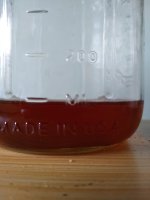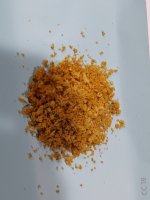Attaching a paper claiming that sulfites can help break up lignin (the material that gives plant cells toughness). See image bellow where there appears to be more openings for extraction when using sulfites with NaOH instead of NaOH alone.
This could help in extractions. As a gross check, I added potassium metabisulfite to some "spent" STB bark. Calling it "spent" after 5x naphta pulls with minimal xtals in the last pull. Ran the "spent" bark with sulfites added through the pressure cooker. Pulling after that (t
he 6th naphta pull) I got xtals. I can't say for sure if it was the PC run that did this though (instead of the sulfites).
I'll do more tests to see if there is anything to do this. I'll simply add sulfite salts (10-20% is my guess) right after basing. These salts are cheap and easy to get. For example, there is a product by bonide called "Stump-Out" that sells for $7/lb and is sodium metabisulfite. It is marketed to remove tree stumps chemically as you might guess.
A good way to check if sulfites can help with DMT extraction from bark would be a split experiment where the control has plain salt added to keep the same ionic strength (moles of salt) as the sulfite condition.
One caution is to avoid sulfites in acid. While lignin is also attacked in this situation by sulfites, toxic SO2 will be released in acidic PH and your house may smell like a stinky paper mill.
This could help in extractions. As a gross check, I added potassium metabisulfite to some "spent" STB bark. Calling it "spent" after 5x naphta pulls with minimal xtals in the last pull. Ran the "spent" bark with sulfites added through the pressure cooker. Pulling after that (t
he 6th naphta pull) I got xtals. I can't say for sure if it was the PC run that did this though (instead of the sulfites).
I'll do more tests to see if there is anything to do this. I'll simply add sulfite salts (10-20% is my guess) right after basing. These salts are cheap and easy to get. For example, there is a product by bonide called "Stump-Out" that sells for $7/lb and is sodium metabisulfite. It is marketed to remove tree stumps chemically as you might guess.
A good way to check if sulfites can help with DMT extraction from bark would be a split experiment where the control has plain salt added to keep the same ionic strength (moles of salt) as the sulfite condition.
One caution is to avoid sulfites in acid. While lignin is also attacked in this situation by sulfites, toxic SO2 will be released in acidic PH and your house may smell like a stinky paper mill.






